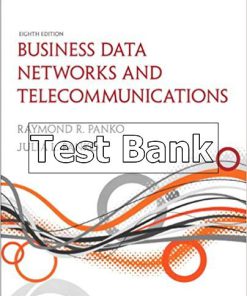Business Data Networks and Security 9th Edition Panko Solutions Manual
$26.50$50.00 (-47%)
Business Data Networks and Security 9th Edition Panko Solutions Manual.
You may also like
This is completed downloadable of Business Data Networks and Security 9th Edition Panko Solutions Manual

Product Details:
- ISBN-10 : 0132742934
- ISBN-13 : 978-0132742931
- Author:
Business Data Networks and Telecommunications guides readers through the details of networking with its clear writing style, job-ready detail, and focus on the technologies that are used in today’s marketplace.
Table of Content:
Chapter 1:
Business plan for microwave slow cookers
Before setting up the plan the requirements and overheads are to be calculated first. There may be numerous counts of overhead like upgrades in network equipment’s and connected devices.
Connecting all four PC’s in a wireless network need proper configuration and maintenance along with proper management of services
A list of problem faced is given below:
1. Purchasing of service (DSL or cable modem) for sufficient speed.
2. A wireless access router for spreading bandwidth range all over the workplace.
3. Configuration and connectivity of modems, routers and all individual computers.
4. Security configuration for sensitive data like billing and processing.
5. Maintenance of network and associated equipment’s.
6. Connectivity cables, wiring of standard quality.
Along with the above problems, there may arise problem related to proper working procedure. Some of the problems are given below:
1. Accounting and billing.
2. Service request and maintenance.
3. Order processing and delivery.
4. Feedback, suggestion and complaints.
Chapter 2:
Making connectionless protocol reliable
Protocols are a set of rules that need to be implemented in software and run by two nodes that need to exchange data.
Examples of protocols:
• TCP (Transmission Control Protocol)
• UDP (User Data Gram Protocol)
• Ethernet
• IP (Internet Protocol)
Except TCP all are connectionless protocols. TCP is connection-oriented protocol.
There are primarily two types of protocols:
1. Connection Oriented Protocols
2. Connectionless Protocols
Both types of protocols are described below:
1. Connection-oriented protocol:
• Connection-oriented protocol allows each message that has to effectively transmitted, to have unique number.
• This number is known as the sequence number. The sequence number plays an important role of ensuring that no message is missing during transmission.
• An example of Connection-oriented protocol is the TCP protocol.
• TCP is a reliable protocol, which implies to have the mechanism essential for error correction.
2. Connection less protocols:
• Connection-less protocol are relatively less reliable for transmission of messages.
• Data unit, is given a destination address, and is sent.
• No prior path, for an effective dialog of message transmitted, is established. Internet Protocol and User Datagram Protocol are some examples of connectionless protocols.
Major challenge on connectionless protocol is lack of a proper error correction mechanism. This can often cause malfunctioning, leading to incorrect delivery of messages.
Ensuring reliability in connectionless protocol:
Usually, the alternative to connectionless protocol is connection oriented protocol. But the short comings, of connectionless protocols can be resolved, at least to ensure reliability.
• Reliable connectionless protocols, can establish a firm 1-way communication without the complication, of creating and then destroying a dedicated channel, solely for the process.
• This can be achieved, by using the transport layer features.
• The transport layer breaks the data, into several fixed sized message components, or packets.
• Then the layer generates a header for each such packet.
• Header describes sequences, keeping the given original data, in view.
• Following this, the packets are transferred to destination node.
• When they are received, destination node compiles the packets based on information in header.
• In brief, the process is a modification of the TCP protocol.
• Other ways, can also, to use those algorithms that are responsible for connection-oriented protocols.
• Such algorithms may provide error detection methods and congestion-control schemes.
In this way, it is possible to achieve reliability up to some extent using connectionless protocols.
Therefore, it is not possible achieve 100% reliability using connectionless protocols.
People Also Search:
business data networks and security panko
business data networks and security 9th edition panko
business data networks and security
business data networks and security 9th edition
business data networks and security 9th edition solution manual download pdf
business data networks and security 9th edition download scribd












